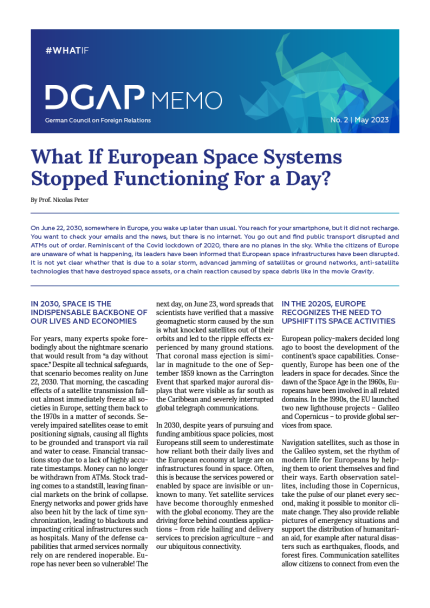In 2030, Space Is the Indispensable Backbone of Our Lives and Economies
For years, many experts spoke forebodingly about the nightmare scenario that would result from “a day without space.” Despite all technical safeguards, that scenario becomes reality on June 22, 2030. That morning, the cascading effects of a satellite transmission fallout almost immediately freeze all societies in Europe, setting them back to the 1970s in a matter of seconds. Severely impaired satellites cease to emit positioning signals, causing all flights to be grounded and transport via rail and water to cease. Financial transactions stop due to a lack of highly accurate timestamps. Money can no longer be withdrawn from ATMs. Stock trading comes to a standstill, leaving financial markets on the brink of collapse. Energy networks and power grids have also been hit by the lack of time synchronization, leading to blackouts and impacting critical infrastructures such as hospitals. Many of the defense capabilities that armed services normally rely on are rendered inoperable. Europe has never been so vulnerable! The next day, on June 23, word spreads that scientists have verified that a massive geomagnetic storm caused by the sun is what knocked satellites out of their orbits and led to the ripple effects experienced by many ground stations. That coronal mass ejection is similar in magnitude to the one of September 1859 known as the Carrington Event that sparked major auroral displays that were visible as far south as the Caribbean and severely interrupted global telegraph communications.
In 2030, despite years of pursuing and funding ambitious space policies, most Europeans still seem to underestimate how reliant both their daily lives and the European economy at large are on infrastructures found in space. Often, this is because the services powered or enabled by space are invisible or unknown to many. Yet satellite services have become thoroughly enmeshed with the global economy. They are the driving force behind countless applications – from ride hailing and delivery services to precision agriculture – and our ubiquitous connectivity.
In the 2020s, Europe Recognizes the Need to Upshift Its Space Activities
European policy-makers decided long ago to boost the development of the continent’s space capabilities. Consequently, Europe has been one of the leaders in space for decades. Since the dawn of the Space Age in the 1960s, Europeans have been involved in all related domains. In the 1990s, the EU launched two new lighthouse projects – Galileo and Copernicus – to provide global services from space.
Navigation satellites, such as those in the Galileo system, set the rhythm of modern life for Europeans by helping them to orient themselves and find their ways. Earth observation satellites, including those in Copernicus, take the pulse of our planet every second, making it possible to monitor climate change. They also provide reliable pictures of emergency situations and support the distribution of humanitarian aid, for example after natural disasters such as earthquakes, floods, and forest fires. Communication satellites allow citizens to connect from even the most remote places, reducing the digital divide on the continent. In March 2023, the EU launched its Infrastructure for Resilience, Interconnectivity, and Security by Satellite (IRIS²) to provide secure high-speed broadband internet communications in Europe.
While space-based solutions provide many benefits, reliance on them can turn into a weakness if they are not adequately protected. After the Ministerial Level Council in November 2022, the European Space Agency (ESA) started to work along two pillars to protect European assets. First, “Security for Space” aims to protect sensitive assets and monitor the threat landscape and vulnerabilities such as cyberthreats affecting Europe’s space operational systems. Second, “Civil Security from Space” aims to interconnect satellites, drones, high-altitude platform stations, and objects (Internet of Things) in space and the air, as well as on ground, into a system-of-systems to deliver services to end-users in a faster and secure way.
In March 2023, the European External Action Service and European Commission released the first-ever EU Space Strategy for Security and Defense that proposes actions to strengthen the resilience and protection of space systems and services in the EU.
Such realizations of how dependent Europe is on its space infrastructures highlight the need for sustained effort to support its activities in space and invest in new avenues. These include not only expanding existing efforts related to space sustainability or civil security from space, but also driving bold new endeavors such as those to establish European capability in human space flight.
Europe Must Live Up to the Space Challenge
For Europe, being a space power is essential to its enduring prosperity. The major breakthroughs achieved by the Apollo Program offer a historical example. In the 1960s, that program mobilized talent and fostered cutting-edge R&D across the entire US economy. Its global and domestic effects still serve the United States decades later. Similarly, Europe’s capacity to send astronauts to space will affect its geopolitical influence, economic gain, and social welfare for the significant future.
Although European decision-makers increasingly recognize the need for boosting space investments, further efforts are necessary. While the achievements of the ESA, EU, and individual spacefaring member states have long made Europe a technology setter, others are now moving faster. For years, major world powers like the United States, China, Japan, and India, as well as regional ones like the United Arab Emirates, have been massively investing in their space-industrial base. They have launched bold new space plans, including those for human space exploration, low earth orbit satellites, and lunar missions.
In this new race to space, Europe first missed its opportunity to establish an independent human launch capacity. That lack was highlighted in the March 2023 report Revolution Space: Europe’s Mission for Space Exploration and reiterated at the Space Summit in November 2023. Thus, it became clear that creating human launch capability would not only confirm Europe as a credible geopolitical and geoeconomic power but also open new horizons for its science and technology. Finally, space was widely embraced as a major transformative force it is.

